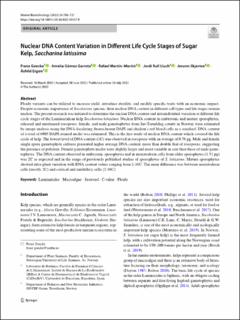| dc.contributor.author | Goecke, Franz Ronald Saavedra | |
| dc.contributor.author | Gómez Garreta, Amelia | |
| dc.contributor.author | Martín–Martín, Rafael | |
| dc.contributor.author | Rull Lluch, Jordi | |
| dc.contributor.author | Skjermo, Jorunn | |
| dc.contributor.author | Ergon, Åshild Gunilla | |
| dc.date.accessioned | 2023-01-12T10:17:07Z | |
| dc.date.available | 2023-01-12T10:17:07Z | |
| dc.date.created | 2022-08-23T12:28:12Z | |
| dc.date.issued | 2022 | |
| dc.identifier.citation | Marine Biotechnology. 2022, 24 706-721. | en_US |
| dc.identifier.issn | 1436-2228 | |
| dc.identifier.uri | https://hdl.handle.net/11250/3042947 | |
| dc.description.abstract | Ploidy variants can be utilized to increase yield, introduce sterility, and modify specific traits with an economic impact. Despite economic importance of Saccharina species, their nuclear DNA content in different cell types and life stages remain unclear. The present research was initiated to determine the nuclear DNA content and intraindividual variation at different life cycle stages of the Laminarialean kelp Saccharina latissima. Nuclear DNA content in embryonic and mature sporophytes, released and unreleased zoospores, female, and male gametophytes from Sør-Trøndelag county in Norway were estimated by image analysis using the DNA-localizing fluorochrome DAPI and chicken’s red blood cells as a standard. DNA content of a total of 6905 DAPI-stained nuclei was estimated. This is the first study of nuclear DNA content which covered the life cycle of kelp. The lowest level of DNA content (1C) was observed in zoospores with an average of 0.76 pg. Male and female single spore gametophyte cultures presented higher average DNA content, more than double that of zoospores, suggesting the presence of polyteny. Female gametophyte nuclei were slightly larger and more variable in size than those of male gametophytes. The DNA content observed in embryonic sporophytes and in meristoderm cells from older sporophytes (1.51 pg) was 2C as expected and in the range of previously published studies of sporophytes of S. latissima. Mature sporophytes showed intra-plant variation with DNA content values ranging from 2-16C. The main difference was between meristoderm cells (mostly 2C) and cortical and medullary cells (2-16C). | en_US |
| dc.language.iso | eng | en_US |
| dc.publisher | Springer | en_US |
| dc.rights | Navngivelse 4.0 Internasjonal | * |
| dc.rights.uri | http://creativecommons.org/licenses/by/4.0/deed.no | * |
| dc.subject | Ploidy | en_US |
| dc.subject | C-value | en_US |
| dc.subject | Seaweed | en_US |
| dc.subject | Macroalgae | en_US |
| dc.subject | Laminariales | en_US |
| dc.title | Nuclear DNA Content Variation in Different Life Cycle Stages of Sugar Kelp, Saccharina latissima | en_US |
| dc.title.alternative | Nuclear DNA Content Variation in Different Life Cycle Stages of Sugar Kelp, Saccharina latissima | en_US |
| dc.type | Peer reviewed | en_US |
| dc.type | Journal article | en_US |
| dc.description.version | publishedVersion | en_US |
| dc.rights.holder | © The Author(s) 2022 | en_US |
| dc.source.pagenumber | 706-721 | en_US |
| dc.source.volume | 24 | en_US |
| dc.source.journal | Marine Biotechnology | en_US |
| dc.identifier.doi | 10.1007/s10126-022-10137-9 | |
| dc.identifier.cristin | 2045301 | |
| dc.relation.project | Norges forskningsråd: 280534 | en_US |
| cristin.ispublished | true | |
| cristin.fulltext | original | |
| cristin.qualitycode | 1 | |

